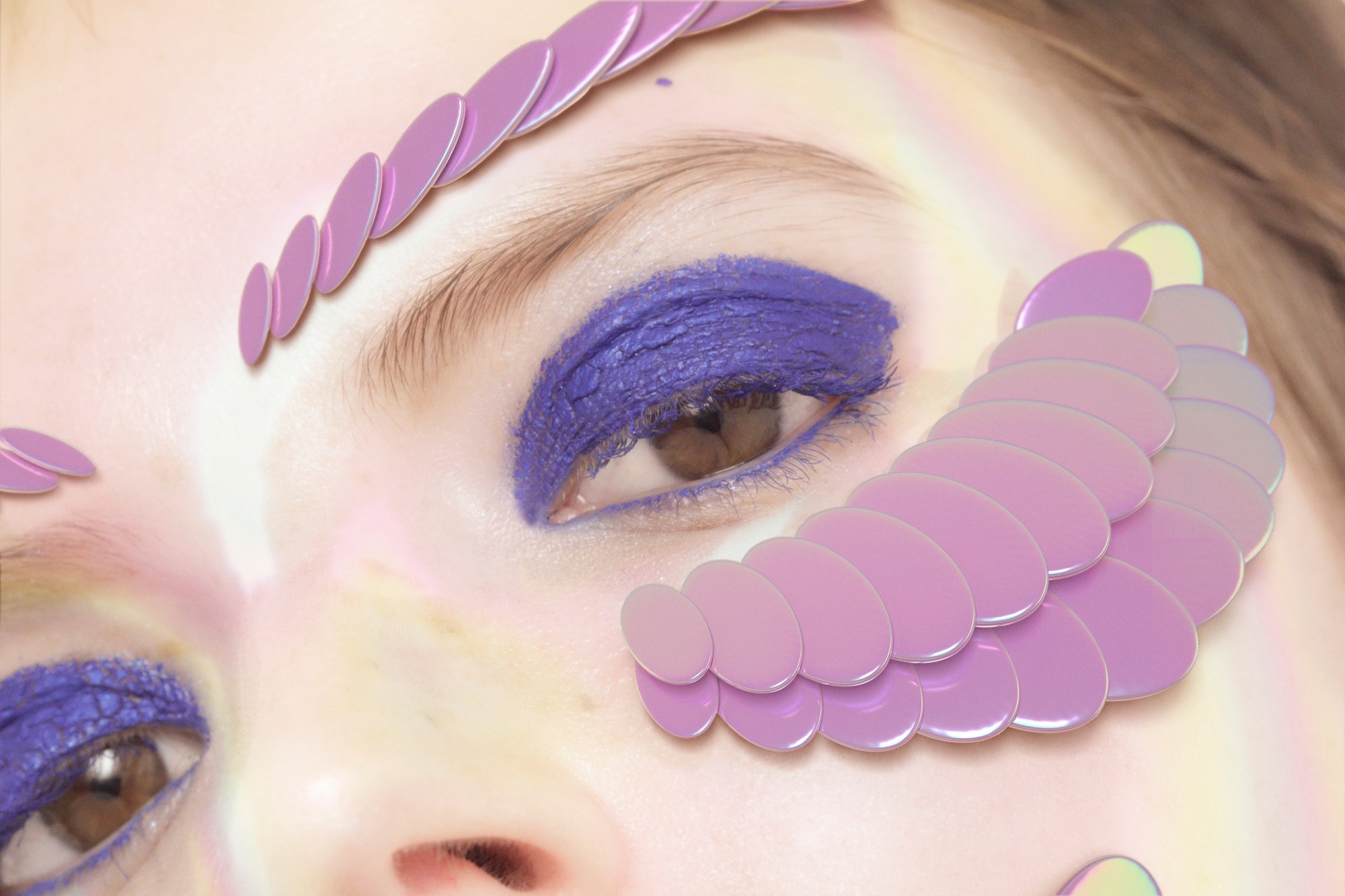Ines Marzat (or Ines Alpha as she is now known) is a make-up artist, but not the regular kind. She’s a make-up artist from the future, who uses CGI software to create the trippiest looks you’ve never even seen. Think eyeshadow made out of sapphires, lipliner from purple stalactites, or pink mutant shapes that swim across your face.
Parisienne-born Ines studied applied arts and management of fashion and design, before moving into the world of advertising, where she learnt about 3D design and CGI software. Now Ines uses her skills to add weird and wonderful digital elements to human faces — all in the name of beauty. Here she shares her story.

“I first started wearing make-up myself when I was around 13 years old. I started with this holographic nail polish I was obsessed with. Next I tried some khôl inside my eyes, my mother hated it because it made me look glum and severe. When I was 14, I wanted to be a photographer, I remember painting half of my best friend’s face in silver. I was going for a futuristic look — very typical of the Y2K era… I was happy with the result. I never went that far myself, I was kind of shy.
I’ve never enjoyed wearing lots of make-up because I always thought it made me look old. The only way I ever enjoyed make-up was when it was used in a creative, whimsical way. I never wore it to hide my defects, or to make myself more beautiful, it was more just to have fun.
I was never confident enough to explore my more bizarre beauty ideas until I turned 20 — there weren’t any available brands or internet-based make-up artists who were showing examples of how to do it until then. I have so many more role models now than I had back in my teenage years, thanks to the rise of social media and YouTube. As a kid my parents used to bring me insane-looking fashion magazines like Fruits from Japan. All the models were made to look like animé characters from punk video games designed by fashion designers. I could never really relate to the traditional models you saw in more mainstream magazines like Vogue, Elle, or Vanity Fair — their silhouette, attitude and looks always felt too strict or out-of-reach for me.
Growing up, I never really felt beautiful, but I didn’t feel totally ugly, either. Like a lot of girls my age, I thought all the boys were always falling in love with my friends rather than me. I also had lots of complexes: thin lips, small breasts, big baby cheeks. That changed when I got older; I feel a lot more confident now, although I still get hung up on some parts of my body, and often find myself comparing my face and body to all the pretty and sexy girls I see on Instagram. Next to them, I feel like I look like a gremlin, but that’s also part of my charm.
I think everyone gets more confident with age. It takes time to experiment, try different things, meet people, discover safe zones, go to parties wearing a crazy make-up, then wearing it a few days later in broad daylight and realizing everything is fine. Test your freedom, see what you are made of. Over the years I’ve discovered new types of artists, drag queens, club kids, that are pushing the boundaries of the stereotypical beauty ideals that we are fed in magazines and fashion campaigns.
One of the main things I experiment with is 3D make-up, made using CGI software. I got into it while working as an art director in advertising, specializing in luxury and beauty. I knew I had an artistic calling somewhere but could not pinpoint it. As time went on, I started experimenting with 3D design as a way of making still life imagery for clients. After spending seven years in the same company, I decided I was ready to take a big leap into the unknown, dedicating my time to what I love doing, which as it turned out was adding digital elements to human faces. I started by adding these elements to found fashion imagery by photographers I love, and began posting online with the hashtag #3Dmake-up.

3D make-up is my vision for the future of beauty. In today’s, and more importantly tomorrow’s society, people will express an ever expanding desire to transform themselves, whether that’s using automated social media filters, advanced make-up techniques or plastic surgery. I consider my work to be an extension of this desire to transform oneself. I don’t really know anyone else doing what I’m doing. I know some artists who make filters for Snapchat, others who experiment with 3D face tracking or create surreal make-up looks using Photoshop and collage. This desire for three dimensional transformation isn’t confined to the digital world. More and more artists are playing around with their faces IRL, creating illusions with objects that they add onto their faces. I’m thinking of Hungry, Lylelox, Tiggy Thorn, Sylwana Zybura, and James Merry, who made Bjork’s masks. Also make-up artists like Mimles who design facial hallucinations.
I truly hope one day we will all be able to wear 3D make-up without the need for a camera. With some kind of holographic technology maybe. Ultimately, to me 3D make-up is about having fun, which is what beauty is all about. It allows you to dream but also be yourself.”
Credits
Agency Monument Agency Paris
3D Artist Ines Alpha
Creative director Antoine Coucoureux
Art director Cassie Daugneau
Video editor Laurent Ferry
Photographer Patrick Parchet
Motion designer Tom Menville
Sound engineer Mickael Bacher
Make-up artist Lisa Mchlik
Model Ioni Guraliuc @ Metropolitan Management
